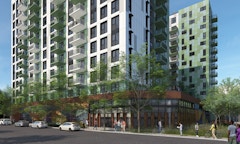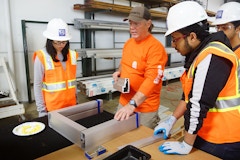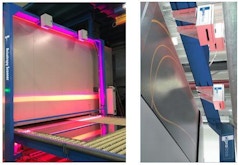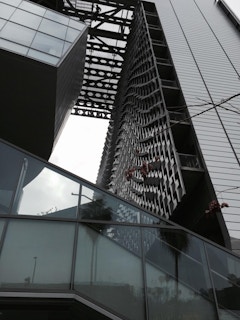
488 results
-
 The structural glass storefront facade at 111 Main Street in Salt Lake City lends itself as a case study in accommodating large building…
The structural glass storefront facade at 111 Main Street in Salt Lake City lends itself as a case study in accommodating large building… -

Contextual Envelopes
- Paper by Zoltan Neville
Aesthetic and technical capabilities of facade design have become seemingly endless as building technologies progress. While the capacity to address
-
Honing the Craft
- Paper by Patrick Delorey
Finishing of custom-fabricated architectural façade components represents one of the most significant components to their cost. Manually driven
-

2025 FTI Forum: NYC! + Vitruvian Honors & Awards Ceremony
- New York, United States
World Congress by Facade Tectonics Institute, Inc.
-
Unitized Cavity Wall Design and Implementation
- Paper by Dan Bettenhausen, Ph.D., Director of Mechanical Engineering
Double Skin Facades (DSF), constructed from individual aluminum framed curtain wall assemblies, provide a means of achieving acoustic and thermal… -

Crucial Conversations of Diversity & Inclusion
- Article by William Green
In architecture, the façade is often the defining aspect of a building’s appearance, establishing the building’s public persona. From an engineering perspective, the façade is an assembly of building components with a critical impact on a range of performative metrics.
-

Modeling Megapanels
- Paper by Elizabeth Bishop, AIA, LEED AP · Emily Green, NCARB, LEED GA · Lisa Podesto, PE
Large format, steel-stud framed “megapanel” facades with rainscreen cladding create uniquely complicated requirements for digital documentation and
-
Anisotropy and Haze Measurement with Online Scanners
- Paper by Rainer Feuster
Architects and facade planners require that anisotropies or haze, optical phenomena disturbing the clear appearance of a glass, have to be avoided
-
Air Spaces Changed Everything
- Paper by Gerry Lang, M.Arch., (Penn, 2008), B. Arch (hons., Toronto, 1978) OAA, AIA,TSA
This abstract proposes that architectural facade design over the last 60 years has convulsed in light of two disruptions: air spaces which create
-

Inside the Box
- Paper by Michael Plewacki
The trend towards modular and unitized facades continues to grow in popularity due largely in part to the efficiencies gained in terms of cost and
-

Bridging the Gap Between Industry and Academia
- Article by Jeffrey Vaglio, PhD, PE, AIA
Fundamentals of Facade Technology: Jeff Vaglio, a proud Facade Geek and lifelong learning proponent, reports on a hands-on industry/academic collaboration at USC. Education is a core mission of the Facade Tectonics Institute, serving both academia and the building profession.
-

-

FTI Announces the Inaugural Vitruvian Honors & Awards Program
- Announcement
The Facade Tectonics Institute is pleased to announce our first biennial Vitruvian Honors & Awards Program, scheduled to take place April 29, 2021 in Los Angeles. The premiere celebration seeks to recognize unprecedented innovation and achievement in the field of facade design and delivery.
-

FTI Extends Abstract Submission Deadline: Topics are Unconstrained!
- Announcement
The Facade Tectonics Institute announces an extension to the abstract submission period for the call for papers for its 2020 World Congress (FTI WC2020) to be convened in Los Angeles on March 25-26. A significant number of inquiries indicated a perception that paper topics were limited to those
-

Shade and Spectacle
- Paper by Warren Techentin, FAIA, NCARB, LEED
This paper will look at the different facades of the Elysian Fields apartment building designed by Warren Techentin Architecture [WTARCH] and
-

Shape Memory Alloy Activated Shading
- Paper by Alberto Speroni, Lorenzo Vercesi, Andrea Giovanni Mainini, Tiziana Poli,
A novel shading device for facade application was developed by combining innovative geometry elements (twisting cylinders) with a smart use of… -

Reflections on Views
- Article by Lisa Heschong
Lisa Heschong, a keynote speaker at the Facade Tectonics Institute’s World Congress in October, is a strong proponent for the importance of daylighting and views in all types of buildings, including this excerpt from her recent book, Visual Design in Architecture: Daylight, Vision, and View.
-

Institute Seeks Paper Review Volunteers For 2016 World Congress
- Announcement
The Facade Tectonics Institute is seeking experienced building industry researchers, academics and practitioners to assist in the 2016 World Congress and Annual Conference paper review process.
-

ETFE Membrane Envelope Strategies
- Paper by Audrey L Worden, ISSF · Kihong R. Ku, DDes · Alexander G. Worden, RA NCARB
Airflow within the cavity of double-skin facades is a key component of adaptive building envelopes which change thermophysical properties to meet
-

2022 World Congress Abstract Submission Deadline Extended Until July 13
- Announcement
The Facade Tectonics Institute has extended the abstract submission deadline until July 13, 2021 for the 2022 World Congress (FTI WC2022).

